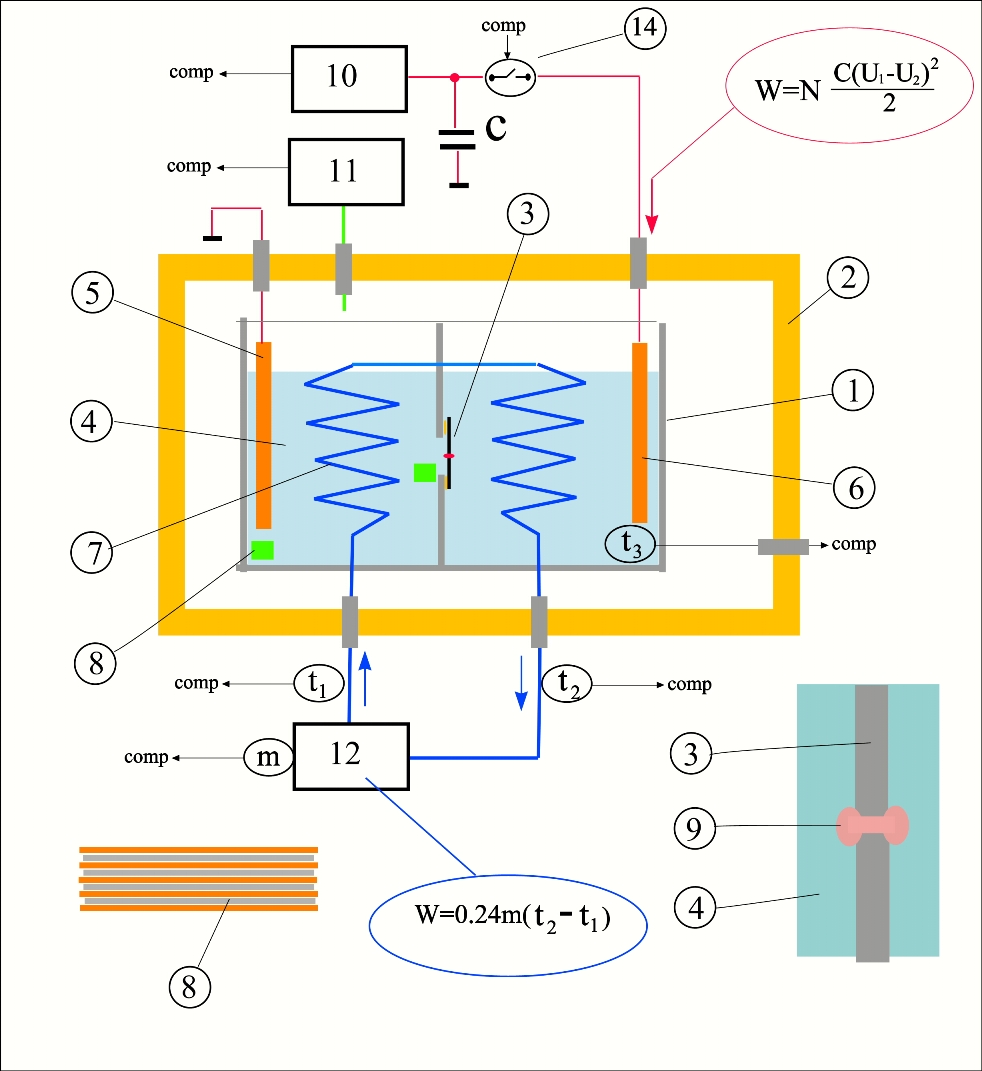|
|
|
|
|
|
|
|
Device for
registration and investigation of Lenr manifestations in conditions of
diaphragm discharge
|
The purpose of this work LENR - Low
Energy Nuclear Reactions - Cold Controlled Nuclear Fusion is a phenomenon that,
despite numerous positive experiments around the world, official science
continues to deny. Therefore, it is still important to propose a simple and
easily reproducible experiment proving the existence of this very relevant
phenomenon. The installation proposed here should register the phenomenon
according to its three manifestations: excessive heat generation, transmutation
of the environment and signs of "strange radiation". A little-studied
process of diaphragm discharge in distilled water is used, when plasma is
excited between liquid electrodes in the holes of a silicon diaphragm.
Installation
design
The figure shows a diagram of the
proposed installation. The galvanic bath (1) with a volume of two liters is
made of a good electrical insulating material, for example, Plexiglas. The bath
is divided by a partition in half, in the middle of the partition there is a
window into which a diaphragm (3) made of a thin monosilicon plate is glued. A
group of holes with a diameter of Heat removal from the bath is carried out using plastic heat exchangers (7), through which water is pumped using a cooling station (12). When gas products appear in a small volume, they are discharged through a recording device (11). To detect "strange radiation", traps (8) consisting of a package of alternating layers of film and copper foil are placed in the bath - one in the discharge zone and one, the control one to the side.
Conducting an experiment
The capacitor (C) is charged from a high-voltage power source (10), when the valve (14) is closed, voltage is applied to the anode of the bath (6). Since the halves of the bath are separated by an insulating partition, all the voltage falls on the small apertures of the diaphragm. A short plasma discharge occurs in them, see work (3).
The capacitance of the capacitor is selected so that the smoldering discharge in the electrolyte does not reach the metal electrodes. The energy entering the heat-insulated space is calculated according to the formula shown in the upper part of the figure. Here (W) is the energy in joules, (C) is the capacitance of the capacitor in farads, (U1) is the voltage to which the capacitor is charged in volts, (U2) is the residual voltage on the capacitor, (N) is the number of pulses. These values can be measured with an accuracy of 0.1%, the computer takes measurements for each pulse and sums up the energy injected into the camera for a certain period of time. The energy output from the chamber is
calculated by the computer using the formula at the bottom of the figure.
Temperatures (t1) and (t)2 can also be measured with an accuracy of 0.1%, with
the mass of water passed through the radiator (m) is more difficult, but, if
necessary, it is possible to complicate the station (12) and measure water
through a measuring beaker. In general, the balance of incoming and outgoing
energy from the insulated space can be performed with an accuracy of 0.5%. It is reasonable to maintain the tempo of the pulses set by the computer so that the difference (t2 – t1) is 20, 25 degrees Celsius, the measurement (t3) is not significant. We don't care how the energy injected into the chamber is redistributed. If the thermal part of the Lenr effect does not manifest itself, the heat balance due to the imperfection of the thermal insulation of the box will be 1-2 percent negative. The discharge process in pure water is usually not accompanied by the reduction of atoms from ions, therefore significant release of gases (oxygen, hydrogen) is not expected, and the transfer of copper cations is also unlikely. There will also be no loss of water for evaporation in a closed bath at a temperature below 50 degrees. Made of monosilicon (used in the manufacture of chips), the diaphragm is quite stable under cavitation, which occurs when vapor bubbles collapse. This allows the experiment to be carried out for a long time (several days), which will make obvious the possible phenomena of transmutation in the bath water and changes in the film in the "strange radiation" detector (8). After the end of the experiment, a spectral analysis of the electrolyte and possible sediment for traces of transmutation is carried out. Additional considerations
How can a
real job be interesting, what new can it show? The peculiarity of the proposed installation
is its compactness in combination with the intensity of internal processes. It
is easy to insulate it and accurately, without ambiguity, take into account the
balance of incoming and outgoing energy. In addition, the new approach
encourages participants to search for new solutions. Igor Rulev 04.2023 г.
|
![]()



